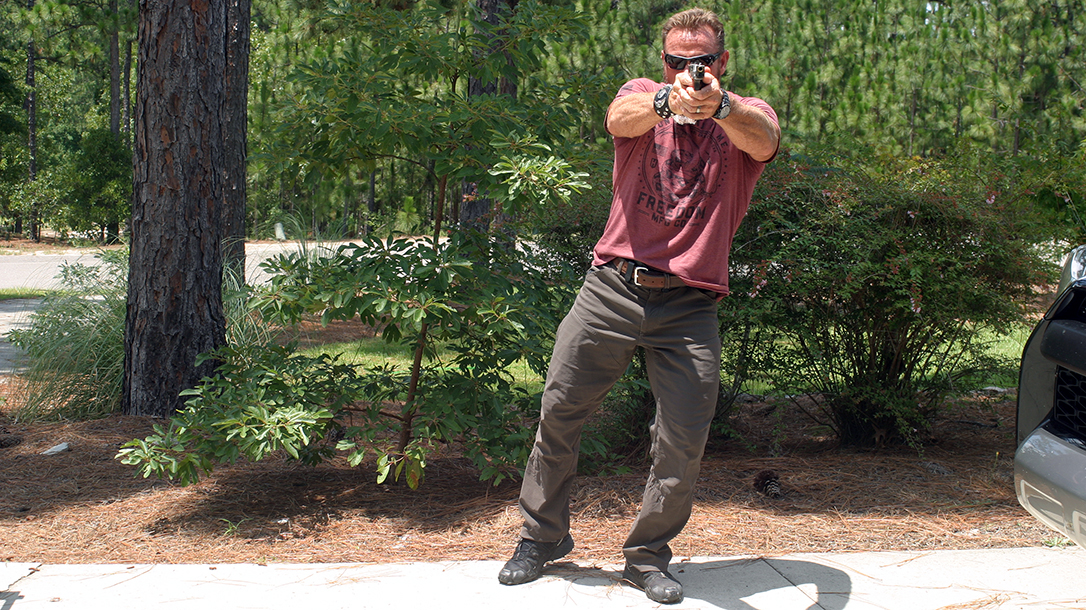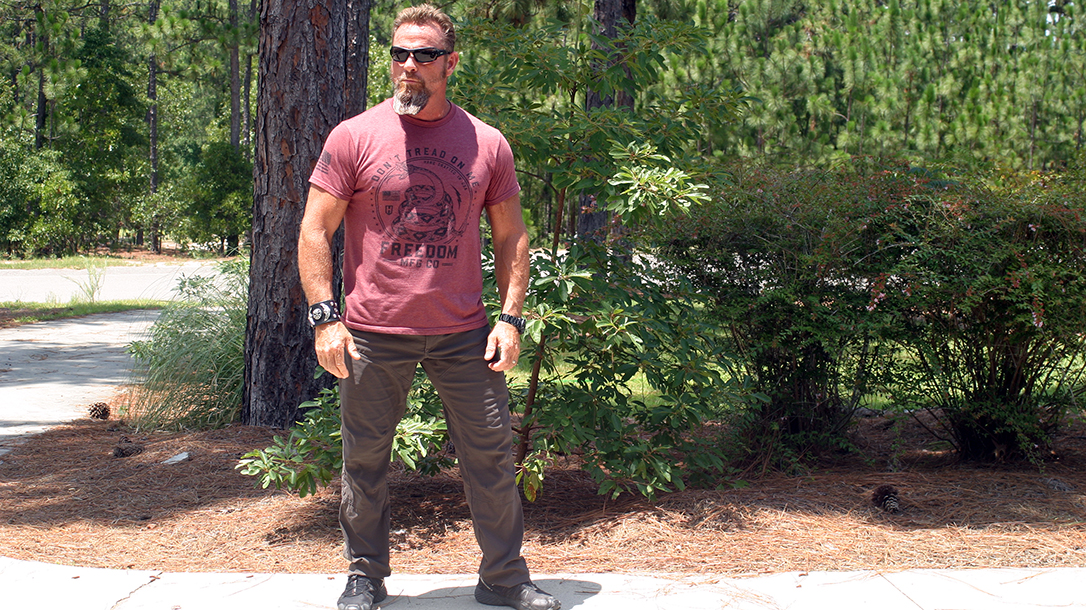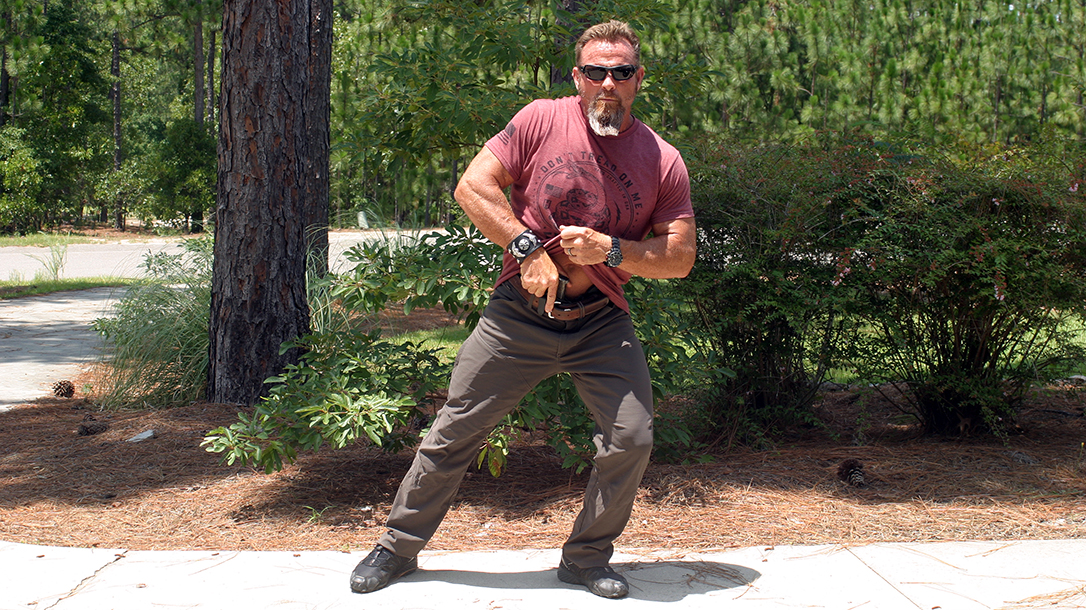You aren’t armed just because you have a gun. The mind is the final weapon. Everything else is supplemental.
I believe that most confrontations will be physical rather than lethal. Escalation of force must be considered in any confrontation. The first thing to consider is that the best way to get out of a bad situation is to not get there in the first place. Don’t beg for attention and achieve separation if the situation dictates that you do not have to be there.
Advertisement — Continue Reading Below
When to Draw Your Weapon
If a confrontation cannot be avoided, or if duty calls and dictates that you should be there for the good and protection of others, then size up the situation. If a would-be douchebag adversary has confronted you or someone who requires your professional assistance, stay “zone aware.” Do not close on or stand chest to chest with the ass clown. You can never underestimate the makeup of a human being.
A predator is looking for easy prey and an opportunity to strike. Stay out of his zone. This zone is a distance from where he can throw a haymaker or thrust with a blade. Don’t back up, either. Instead, assume an “interview stance,” as used by police officers. Talk in a disarming, non-aggressive posture with your hands open between you and the dickhead. Your arms should be close to your body. You are also slightly bladed, slightly athletic in your stance without appearing aggressive.
At some point in your disarming dialogue, take an obvious step to the left while adjusting your verbiage. This is nothing more than tactical deception. You are putting a bug in the aggressor’s mind. He’ll ask himself, “What does this guy know, and do I want to find out what this guy knows?”
Advertisement — Continue Reading Below
Gain The Advantage
You see, a human predator is just like any predator in the wild. They need to take easy prey. If you appear to have the magic, this may dissuade him to look elsewhere for a target.
This same deception can be used during a lethal confrontation. If you are face to face with a potentially lethal opponent (“potentially” only because he has not yet made a move), both of you are thinking about your next act. You are in a virtual chess match where a nanosecond can make the difference between life and death. Brain defaults will force you to make the first move, or react, based on actions presented to you.
Police officers work in a profession where deadly uncertainty and terrifying unpredictability are commonplace. They find themselves relying on split-second decisions to save there own lives and safeguard others. Most decisions, good or bad, are products of training. Many others are hard-drive-default mechanism reactions. These defaults are usually correct.
Advertisement — Continue Reading Below
Interview Stance
The interview stance offers tactical deception. You are appearing non-aggressive but are still ready for spontaneous, non-telegraphic movement similar to that of a jungle cat. Next time you are in an interview situation and determine that the person in front of you is likely to act violently, move 12 inches laterally and watch the person’s reaction. You are going to throw him off track. He will find himself outside of his comfort zone because you made a benign movement. This automatically gives you a physical and tactical advantage while placing him at a mental disadvantage.
If you are in a sparring match with a lethal opponent, a simple move laterally to your left or right will often throw your opponent off and allow you the valuable time you need to execute your plan, and yes, you should have a plan. And it should be one you have rehearsed many times.
Drawing Down
At what point is the threat apparent enough that you should draw your pistol? And if you are standing stationary when you draw, why do we call it a “tactical draw stroke”? If you are standing stationary, you are not using tactics.
Advertisement — Continue Reading Below
A tactical draw stroke is commonly taught step by step in accordance with draw stroke doctrine. This doctrine is normally slightly modified from instructor to instructor. There is no magic to it, and there is nothing tactical about it. Why don’t we just call it what it is? It is a pistol draw. Adding “tactical” to an action or object adds sex appeal but doesn’t change what it actually is.
Remember, if you are drawing a pistol, it is because someone dangerous is directly in front of you. This bad guy is relying on your predictability and his defaults. His intentions are bad.
Advertisement — Continue Reading Below
Bring Movement into the Draw
So here is my suggestion. Take a short lateral step to the left when you perform your tactical draw stroke. It won’t slow your draw down or throw you off balance. But it will encourage the thought process—your brain works more efficiently when you are moving—and minimize your predictability. It will also temporarily throw off your adversary, which will increase your lethality. In a gunfight, temporary is an eternity. Being lethal is non-negotiable.
Why step to the left? It’s estimated that about 93-percent of the adult population is right-handed. In addition, most people can’t shoot. Most of them will jerk the trigger, which will lead them to hit low and left. But stepping right or left isn’t the important part. What matters is movement. Mobility equals survivability.
We’ve added movement into our draw stroke to eliminate predictability. We’ve also increased our lethality, which assists in survivability. Now we can call it what it has become—a tactical draw stroke.
Advertisement — Continue Reading Below
This article is from the November-December 2019 issue of Combat Handguns magazine. Grab your copy at OutdoorGroupStore.com. For digital editions, visit Amazon.

























